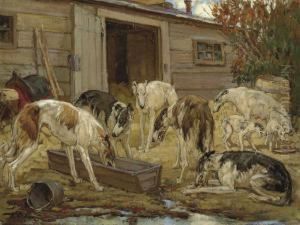Georgii Savitskii Paintings
Georgii Ivanovich Savitskii was a Russian realist painter and graphic artist, notable for his depictions of the Russian peasantry, landscapes, and industrial scenes. Born on August 12, 1887, in the city of Zaisan in the Russian Empire (now located in Kazakhstan), Savitskii showed an early interest in art. His formative years as an artist were influenced by the social and political environment of his time, particularly the events leading up to and following the Russian Revolution of 1917.
Savitskii received his formal art education at the Moscow School of Painting, Sculpture and Architecture, where he studied from 1908 to 1918. During his studies, Savitskii was exposed to the works of prominent Russian artists of the period, which influenced his artistic style. He was particularly drawn to the realist approach, which focused on the truthful and objective representation of subjects, often depicting everyday life and the working class.
Throughout his career, Savitskii remained committed to the realist tradition, despite the changing artistic trends and the rise of Soviet Socialist Realism. His works often reflected the lives of ordinary people, and he was known for his ability to capture the mood and atmosphere of the Russian countryside. Savitskii's landscapes and scenes of rural life were praised for their sincerity and emotional depth.
During the 1920s and 1930s, Savitskii worked on a number of industrial themes, reflecting the Soviet Union's focus on industrialization and progress. His paintings from this period often depicted factories, workers, and construction sites, showcasing the transformation of the Soviet landscape.
Georgii Savitskii's contributions to Russian art were recognized during his lifetime, and he received various awards and honors. He was a member of the Union of Soviet Artists and participated in numerous exhibitions, both in the Soviet Union and abroad.
Savitskii's artistic legacy is preserved in the collections of several Russian museums, including the State Tretyakov Gallery in Moscow and the State Russian Museum in St. Petersburg. His work continues to be studied and appreciated for its portrayal of Russian life and the artist's dedication to realism.
Georgii Ivanovich Savitskii passed away on July 7, 1949, leaving behind a significant body of work that captures a pivotal period in Russian history. His paintings remain an important part of the cultural heritage of Russia, reflecting the spirit and the struggles of the Russian people during the first half of the 20th century.
